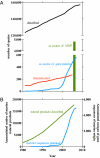What lies underneath: conserving the oceans' genetic resources
- PMID: 20837523
- PMCID: PMC2972965
- DOI: 10.1073/pnas.0911897107
What lies underneath: conserving the oceans' genetic resources
Abstract
The marine realm represents 70% of the surface of the biosphere and contains a rich variety of organisms, including more than 34 of the 36 living phyla, some of which are only found in the oceans. The number of marine species used by humans is growing at unprecedented rates, including the rapid domestication of marine species for aquaculture and the discovery of natural products and genes of medical and biotechnological interest in marine biota. The rapid growth in the human appropriation of marine genetic resources (MGRs), with over 18,000 natural products and 4,900 patents associated with genes of marine organisms, with the latter growing at 12% per year, demonstrates that the use of MGRs is no longer a vision but a growing source of biotechnological and business opportunities. The diversification of the use of marine living resources by humans calls for an urgent revision of the goals and policies of marine protected areas, to include the protection of MGRs and address emerging issues like biopiracy or benefit sharing. Specific challenges are the protection of these valuable resources in international waters, where no universally accepted legal framework exists to protect and regulate the exploitation of MGRs, and the unresolved issues on patenting components of marine life. Implementing steps toward the protection of MGRs is essential to ensure their sustainable use and to support the flow of future findings of medical and biotechnological interest.
Conflict of interest statement
The authors declare no conflict of interest.
Figures



References
-
- Johannes RE. Traditional marine conservation methods in Oceania and their demise. Annu Rev Ecol Syst. 1978;9:349–364.
-
- Beverton R, Holt S. On the Dynamics of Exploited Fish Populations. London: Chapman & Hall; 1957.
-
- Committee on the Evaluation, Design, and Monitoring of Marine Reserves and Protected Areas in the United States, Ocean Studies Board, National Research Council. Marine Protected Areas: Tools for Sustaining Ocean Ecosystem. Washington, DC: National Academy Press; 2001.
-
- United Nations Environment Programme (UNEP) and International Union for Conservation of Nature (IUCN) World Database on Marine Protected Areas (WDPA) [Accessed October 23, 2009]. Available at http://www.wdpa-marine.org/#/countries/about.
-
- Cragg GM, Newman DJ. Natural product drug discovery in the next millennium. Pharm Biol. 2001;39:8–17. - PubMed
Publication types
MeSH terms
LinkOut - more resources
Full Text Sources

